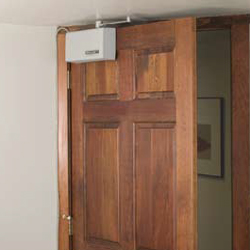Power Door Openers
One of the biggest challenges for people using walkers, scooters, wheelchairs or other mobility prodcuts is getting through doors. To sit in a wheelchairor on a scooter and open a door that has to be pulled towards onself or to pull a door closed after passing through.
Most people are familiar with commercial door openers found in stores and offices that are usually activated by walking onto a mat or by passing by an electric sensor. These are relatively expensive pieces of equipment that aren't designed for and aren't really suitable for residential use.
Most home health care stores and wheelchair vendors who sell and install lifts will also be able to supply power door openers for residential use. These units are designed to be installed on existing swing doors
Although there are a few different manufacturers of door openers for residential use most of the features are common between them. The information on this page refers primarily to the Power Access 2300 Residential Door Opener because I am familiar with the their equipment and they were kind enough to send me information for this article and permit me to use their images.
How They Work
Power door openers for sresidential use are pretty simple affairs that consist of an electric motor that activates a bar that opens and closes the door. The unit can be mounted to the doorframe (pushes the door open) or the door itself (pulls the door open).
The residential door opener can be mounted to either interior or exterior doors (exterior doors should open inward or winds may force the door to close) and the doors can be hollow core, solid, metal and aluminum/glass.
Battery back ups are available for some models but all will need an outlet nearby to provide power to operate the door opener and keep the battery charged.
Operation
When activated the door opener opens the door over about 8 seconds, holds it open for up to 30 seconds (adjustable), and closes the door over another 8 seconds. The power door opener can be be activated with a keyed wall switch, unkeyed wall switch, digital keypad, remote control or pressure mat.
While normally the door openers are fully automatic and stay open for a preset time and then close on their own, some can be set up to require a second action by the user where they activate the opener and the door stays open until they signal it to close behind them. This feature is helpful for people who want to be able to control how long the door will be open every time they use it.
Door Knobs and Locks
Door openers do not turn door knobs or unlock doors. There are a couple of ways to deal with these actions.
- For interior doors that don't require locks the door latch can be removed so it doesn't hold the door closed. The door opener will hold the door closed and the door knobs no longer serve any purpose.
- A second option for interior doors that don't require locking is a special strike plate that doesn't allow the door latch to extend into the door jamb through the strike plate.
- Exterior doors normally require a lock and this creates a problem for the door opener. The way to deal with this is to install an electric door strike which automatically releases the door latch when the door opener is activated. The electric door strikes are basically the same as those seen in a apartment building entrances. The door can be left locked or unlocked when using the electric door strike.

Manual Use
Most residential electric door openers allow the door to be used manually. For exterior doors a person will need a key if the door is left in the locked state but will open the door normally if left unlocked.


 Online Vendors
Online Vendors  US Online Vendors
US Online Vendors 

